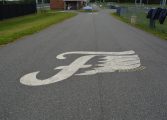Reasons for the decline of insect populations including honeybees are mites, disease, pesticides, colony collapse and encroachment by other insects. The main threat facing wild populations is loss of habitat; native fields, wetlands, and forests. Many wildflowers are rapidly disappearing as well. This is especially hard on migratory pollinators such as bats, butterflies, and hummingbirds which need habitat within a day’s journey to survive the trip.
We can stop using broad spectrum pesticides which kill all insects indiscriminately and we can include native plants in our gardens. Plant in clumps to better attract desirable insects, varying shape and color. Red, orange and white tubular flowers are loved by hummingbirds. Bees like bright white, yellow and blue flowers while butterflies go for bright red and purple with some fragrance. Beetles are attracted to white or green with stronger odors. Flies settle on green, white, cream colors as well as dark brown and purple.
Buckeye and Pawpaw, red-bud and fringe tree are native and are great additions to the landscape. Oak leaf hydrangea, holly and rhododendrons, hawthorne and mock orange all add to the garden and provide for pollinators. Everyone knows milkweed attracts butterflies, but few people want an entire garden of milkweed. Try amsonia, anemone, and baptisia as well as coreopsis, liatris and heuchera. Cardinal flower and Joe Pye weed are big attractors in wet areas. There are many to choose from and we already incorporate a lot of them in our perennial gardens; coneflower and helianthus, phlox and clematis. Your garden will become lively and all the fruits and vegetables will produce better.
If possible, remove pests by hand or, if you must use a pesticide, choose one that is least toxic to non-pest species and does not persist on vegetation. Apply it in the evening when most pollinators are not as active. For more information, go to www.pollinators.org.
© Fluvanna Review 2022. All rights reserved.
Produced by Valley Publishing Group




